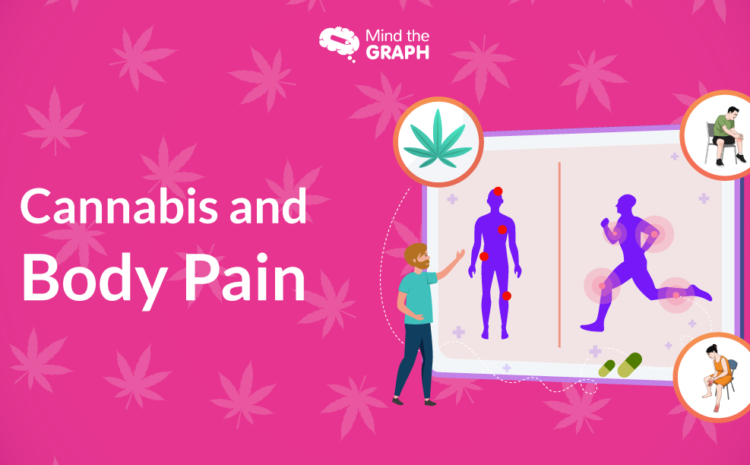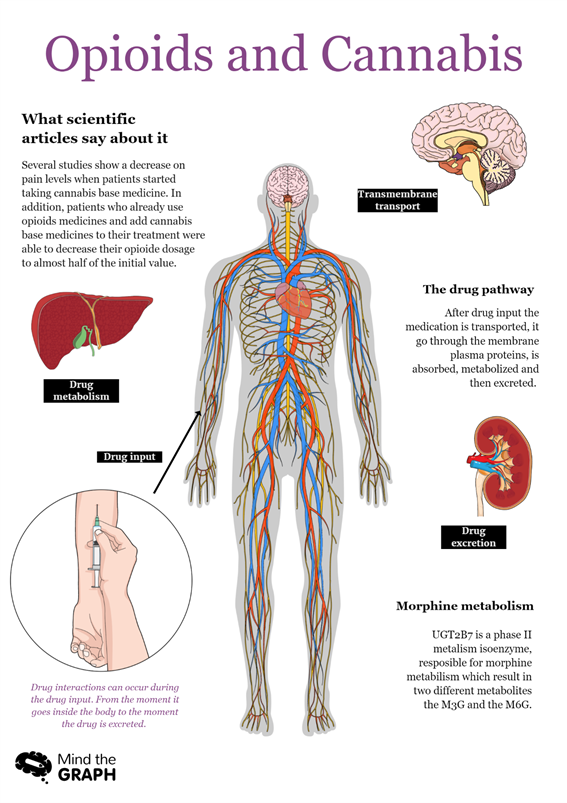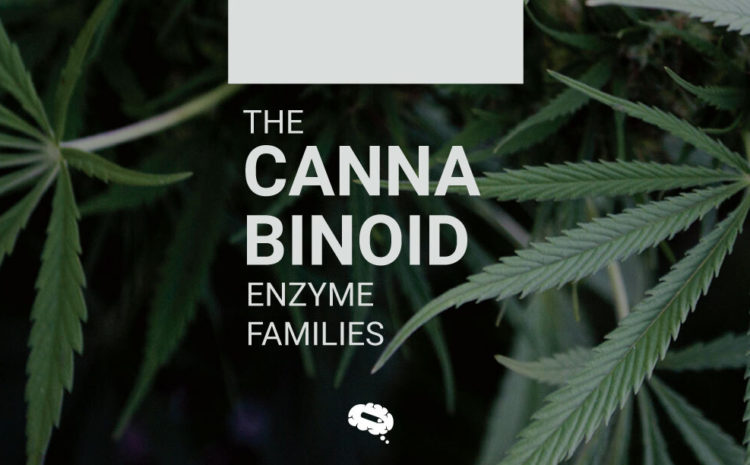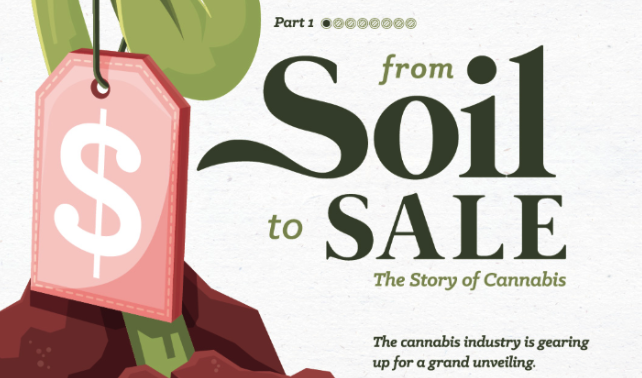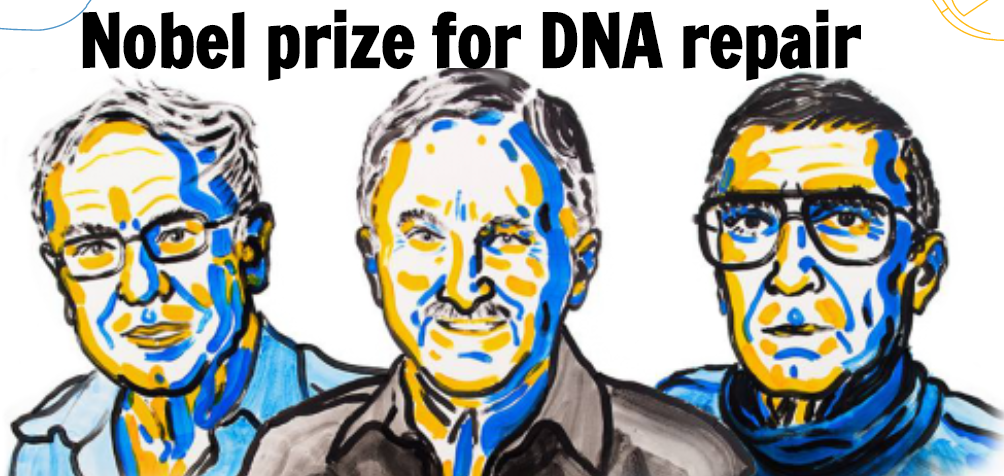I løpet av det siste tiåret har mange kliniske studier rapportert om positive og lovende resultater ved bruk av cannabisbaserte legemidler til behandling av nevropatiske smerter.
Smertelindring i forbindelse med diabetes, cellegift, multippel sklerose, fibromyalgi, slitasjegikt og flere andre sykdommer har blitt behandlet med cannabis.
Apparently, there is a connection between exogenous cannabinoids and opioids receptors, resulting in an increase in patient analgesia – the inability to feel pain.
Patients who are treated with opioids along with cannabis-based medications exhibit a medicament synergic effect, where the opioid efficacy is increased by the tetrahydrocannabinol – THC, the major psychoactive molecule in the cannabis plant.
Forskere ser positivt på disse resultatene fordi de kan redusere doseringen av opioider, noe som kan føre til bedre livskvalitet for smertepasienter.
The endocannabinoid system, likewise other metabolic pathways is not an isolate system of the human body, it can influence and be influenced by other signaling pathways, one of these is apparently related to opioids and its receptors.
I tillegg til at opioidreseptorene signaliserer smerte, har de også til oppgave å modulere visse kroppsfunksjoner, blant annet varmeregulering, hormonell stabilitet og smertestillende aktivitet.
Både cannabinoid- og opioidreseptorer er medlemmer av den G-proteinkoblede familien, som er proteiner som kan påvirke nevrotransmisjonen som er ansvarlig for smerteforplantning i hjernen og ryggmargen.
Behandlingen av pasienter med kroniske smerter innebærer vanligvis gradvis økende doser opioider, noe som ofte fører til uønskede bivirkninger som sedasjon, pusteforstyrrelser og forstoppelse.
Etter en stund begynner pasientene å utvikle toleranse og resistens mot opioiddosen, og oppnår ikke de terapeutiske effektene, noe som tvinger legene til å øke dosen gjentatte ganger for å oppnå samme grad av smertelindring.
En høy dose THC alene anses som smertestillende, men etterfølges vanligvis av uønskede bivirkninger som angst, hodepine, munntørrhet, svimmelhet, eufori og takykardi, mens lave doser ikke gir smertestillende effekt i det hele tatt.
I kombinasjon med opioider kan denne effekten imidlertid endres fullstendig.
Studies conducted in animals’ models have shown that exogenous cannabinoids like THC can increase the efficacy of opioid medicines, like morphine.
THCs smertestillende effekt ser ut til å formidles gjennom opioidreseptorer, med en kryssinteraksjon mellom cannabinoider og opioiders signalveier.
Cannabis researchers report that THC administration can stimulate the production of endogenous opioids peptides in the body, which end up binding to already known opioids receptors – delta and kappa – intermediating the cannabinoid effect.
A third opioid receptor mu is also activated when morphine is administered. The activation of these three opioids receptors may be the explanation of the efficacy increase of the antinociceptive affect – the process of analgesia that blocks the detection of a painful stimulus – when compared to results of treatments of morphine or THC alone.
A studie publisert i 2004 av tidsskriftet Life Sciences bekreftet sammenhengen mellom THC og morfin ved å hemme opioidreseptoren ved hjelp av spesifikke molekyler.
Tilstedeværelsen av blokkerende molekyler resulterte i en reduksjon av morfineffektiviteten, og dermed av de terapeutiske effektene.
This result confirms how important is the availability of these receptors and its activation for morphine – and THC – treatment efficacy. Another experiment conducted with Naloxone – an opioid antagonist – blocked the THC activity in diverse regions of the brain, as ventral tegmental area, hypothalamus and periaqueductal gray (PAG), suggesting that these regions are somehow important to the interaction opioid-cannabinoid.
In addition, the study also reports that mice’s treatment with low doses of THC and morphine together did not lead to dosage opioid tolerance.
Denne og mange andre studier som er publisert, støtter ideen om at cannabinoider i kombinasjon kan øke opioidenes effekt.
Cannabinoider kan tilsynelatende også endre toleransen og avhengigheten av opioider.
Long-term uses of opioids are usually associated with patients’ addiction, leading to the abuse of a substance that initially had only a therapeutic purpose.
Therefore, the combination cannabinoid-opioid – THC and morphine for example – could turn into a new analgesic strategy of combined therapy, allowing doctors to decrease high opioid doses of their patients and also decrease the level of opioid abuse and addiction of patients.
I tillegg til teorien om at cannabinoider stimulerer endogene opioider, er den detaljerte mekanismen for cannabinoid-opioid-interaksjonssystemet fortsatt uklar.
The hypothesis that tries to explain the potential mechanism of action is that cannabinoids maybe induce the synthesis or the release – of both – of opioid peptides, increasing the number of opioids receptors activated, resulting in the analgesic levels.
The elucidation of which peptides are involved in this process is not clear or known either, so, it would be crucial for scientists to fully understand the structure of these molecules and how cannabinoids can be used to produce analgesic effects, beyond assist in opioid addiction.
Howsoever, cannabinoids in general have been demonstrating surprising results, continually gaining space among medical professionals, proving its potential as an alternative medicine.
Det kreves flere studier for at forskerne fullt ut skal kunne forstå de reelle fordelene og mulighetene cannabisbaserte medisiner har for menneskekroppen, og hvordan man best mulig kan bruke cannabisplanten som behandling.
___
Did you like the infographic in this article? All ikoner used in this article – and many more – are available in the Mind the Graph. You can check the available illustrations in our galleri.
And you don’t need to start your infographic from scratch, we offer editable infographic templates to our users, so they don’t need to start from a blank canvas. Her kan du se maler for infografikk.
You can also have a senior subscription and create unlimited figures, Klikk her for å starte!
Referanser
BROWN, J. D.; WINTERSTEIN, A. G. Potensielle uønskede legemiddelhendelser og interaksjoner mellom legemidler ved medisinsk bruk av cannabidiol (CBD). Journal of Clinical Medicine, v. 8, n. 7, 8 jul. 2019.
CICHEWICZ, D. L. Synergistic interactions between cannabinoid and opioid analgesics. Life Sciences, v. 74, n. 11, p. 1317–1324, 30 jan. 2004.
HANEY, M.; BISAGA, A.; FOLTIN, R. W. Interaction between naltrexone and oral THC in heavy marijuana smokers. Psychopharmacology, v. 166, n. 1, p. 77–85, 1 fev. 2003.
KUHLEN, M. et al. Effective treatment of spasticity using dronabinol in pediatric palliative care. European Journal of Paediatric Neurology, v. 20, n. 6, p. 898–903, 1 nov. 2016.
LÖTSCH, J. et al. Drug Interactions with Patient-Controlled Analgesia. Clinical Pharmacokinetics, v. 41, n. 1, p. 31–57, 1 jan. 2002.
LYNCH, M. E.; CLARK, A. J. Cannabis Reduces Opioid Dose in the Treatment of Chronic Non-Cancer Pain. Journal of Pain and Symptom Management, v. 25, n. 6, p. 496–498, 1 jun. 2003.
MANZANARES, J. et al. Pharmacological and biochemical interactions between opioids and cannabinoids. Trends in Pharmacological Sciences, v. 20, n. 7, p. 287–294, 1 jul. 1999.
WAKLEY, A. A.; CRAFT, R. M. THC−methadone and THC−naltrexone interactions on discrimination, antinociception, and locomotion in rats. Behavioural Pharmacology, v. 22, n. 5 and 6, p. 489–497, set. 2011.
WELCH, S. P. Interaction of the cannabinoid and opioid systems in the modulation of nociception. International Review of Psychiatry, v. 21, n. 2, p. 143–151, 1 jan. 2009.

Abonner på nyhetsbrevet vårt
Eksklusivt innhold av høy kvalitet om effektiv visuell
kommunikasjon innen vitenskap.

